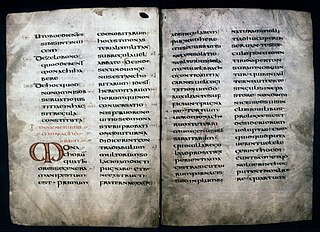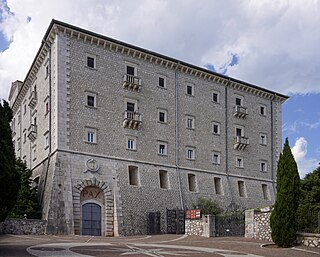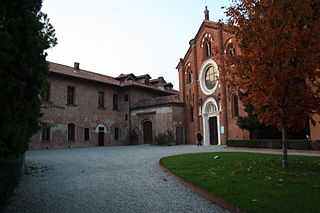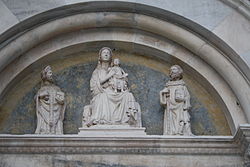Ambrosians are members of one of the religious brotherhoods which at various times since the 14th century have sprung up in and around Milan, Italy. In the 16th century, a sect of Anabaptist Ambrosians was founded.

The Benedictines, officially the Order of Saint Benedict, are a mainly contemplative monastic order of the Catholic Church for men and for women who follow the Rule of Saint Benedict. Initiated in 529 they are the oldest of all the religious orders in the Latin Church. The male religious are also sometimes called the Black Monks, especially in English speaking countries, after the colour of their habits. Not all Benedictines wear black, however, with some like the Olivetans wearing white. They were founded by Benedict of Nursia, a 6th-century Italian monk who laid the foundations of Benedictine monasticism through the formulation of his Rule. Benedict's sister, Scholastica, possibly his twin, also became a religious from an early age, but chose to live as a hermit. They retained a close relationship until her death.

The Rule of Saint Benedict is a book of precepts written in Latin c. 530 by St. Benedict of Nursia for monks living communally under the authority of an abbot.

Monte Cassino is a rocky hill about 130 kilometres (80 mi) southeast of Rome, in the Latin Valley, Italy, 2 kilometres west of Cassino and at an elevation of 520 m (1,710 ft). Site of the Roman town of Casinum, it is widely known for its abbey, the first house of the Benedictine Order, having been established by Benedict of Nursia himself around 529. It was for the community of Monte Cassino that the Rule of Saint Benedict was composed.

Peter of Verona, also known as Saint Peter Martyr and Saint Peter of Verona, was a 13th-century Italian Catholic priest. He was a Dominican friar and a celebrated preacher. He served as Inquisitor in Lombardy, was killed by an assassin, and was canonized as a Catholic saint 11 months after his death, making this the fastest canonization in history.

Odo of Cluny was the second abbot of Cluny.

Christian monasticism is a religious way of life of Christians who live ascetic and typically cloistered lives that are dedicated to Christian worship. It began to develop early in the history of the Christian Church, modeled upon scriptural examples and ideals, including those in the Old Testament. It has come to be regulated by religious rules and, in modern times, the Canon law of the respective Christian denominations that have forms of monastic living. Those living the monastic life are known by the generic terms monks (men) and nuns (women). The word monk originated from the Greek μοναχός, itself from μόνος meaning 'alone'.
The Humiliati were an Italian religious order of men formed probably in the 12th century. It was suppressed by a papal bull in 1571 though an associated order of women continued into the 20th century.

Seveso is a town and comune in the Province of Monza and Brianza, in the Region of Lombardy. The economy of the town has traditionally been based on the furniture industry.

Meda is a town and comune in the province of Monza and Brianza, located in the northern Italian region of Lombardy, close to Milan and Como. It is a center of furniture production.

One of the first streams of Romanesque architecture in Europe from the 10th century and the beginning of 11th century is called First Romanesque or Lombard Romanesque. It took place in the region of Lombardy and spread into Catalonia and into the south of France. Its principal decoration for the exterior, bands of ornamental blind arches are called Lombard bands. It was characterized by thick walls and lack of sculpture in facades, and with interiors profusely painted with frescoes.

Cabiate is a comune (municipality) in the Province of Como in the Italian region Lombardy, located about 20 kilometres (12 mi) north of Milan and about 20 kilometres (12 mi) southeast of Como.
Rovello Porro is a comune (municipality) in the Province of Como in the Italian region of Lombardy, located about 25 kilometres (16 mi) northwest of Milan and about 20 kilometres (12 mi) south of Como. As of 31 December 2004, it had a population of 5,797 and an area of 5.6 square kilometres (2.2 sq mi).

The Abbey of Santa Maria di Rovegnano is a Cistercian monastic complex in the comune of Milan, Lombardy, northern Italy. The borgo that has developed round the abbey was once an independent commune called Chiaravalle Milanese, now included in Milan and referred to as the Chiaravalle district.

The Abbey of Viboldone is an abbey in Viboldone, a frazione of San Giuliano Milanese, in the province of Milan, northern Italy.

Mirasole Abbey is a monastery in the comune of Opera near Milan, Lombardy, Northern Italy. The monastery was initially founded by the Humiliati in the 13th century. The buildings have had diverse uses over the centuries. Since 2013, houses a community of the Premonstratensians.

Morimondo Abbey is a former Cistercian monastery located at Morimondo, a few kilometers south of Abbiategrasso in the Metropolitan City of Milan, Lombardy, northern Italy. The surviving structure is Romanesque and Gothic. It was founded in 1134 as a daughter house of Morimond Abbey near Dijon, from which it took its name.

Saint Ambrose is a small church which is an annex to the farmhouse that takes its name from it, in Brugherio, Italy.

Peter was an Italian Cistercian monk and prelate. He was the abbot of Rivalta from 1180 until 1185, abbot of Lucedio from 1185 until 1205, abbot of La Ferté from 1205 until 1206, bishop of Ivrea from 1206 until 1208 and patriarch of Antioch from 1209 until his death. He is known as Peter of Magnano, Peter of Lucedio or Peter of Ivrea.
Gerardo da Sesso was an Italian monk, bishop and cardinal of the Catholic Church.
















